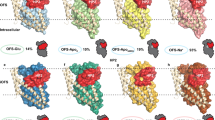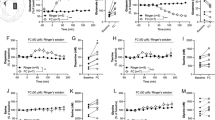Abstract
GLUTAMIC acid is the primary candidate for a role as an excitatory transmitter at synapses mediating the primary afferent pathway and cortical pathways in mammals1. Seeking to gain evidence for this, various laboratories have looked for a mechanism for the eflficient removal of glutamic acid from the synaptic cleft. Following the paradigm of monoamine synapses, in which high affinity uptake systems apparently localised in the presynaptic membrane remove transmitter after its action at the postsynaptic membrane2, high affinity uptake systems for glutamate removal have been sought. Logan and Snyder3 described a high affinity transport system for glutamate in a synaptosomal preparation, and postulated that it might serve to localise glutamate-mediated synapses. Recent evidence has suggested that the transport systems involved in the removal of putative amino acid transmitters from the synaptic cleft are not localised exclusively in the synapse.
This is a preview of subscription content, access via your institution
Access options
Subscribe to this journal
Receive 51 print issues and online access
$199.00 per year
only $3.90 per issue
Buy this article
- Purchase on Springer Link
- Instant access to full article PDF
Prices may be subject to local taxes which are calculated during checkout
Similar content being viewed by others
References
Hammerschlag, R., and Weinreich, D., in Adv. Biochem. Psychopharmac. (edit. by Costa, E., and Greengard P.), 6, 165–180 (Raven Press, New York, 1972).
Iversen, L. L., The uptake and storage of nonadrenaline in sympathetic nerves (Cambridge University Press London, 1967).
Logan, W. J., and Snyder, S. H., Nature, 234, 297–299 (1971); Brain Res., 42, 413–21 (1972).
Henn, F. A., and Hamberger, A., Proc. natn. Acad. Sci. U.S.A., 68, 2686–2690 (1971).
Orkand, P. M., and Kravitz, E. A., J. Cell Biol., 49, 75–89 (1971).
Neal, M. J., and Iversen, L. L., Nature new Biol., 235, 217–218 (1972).
Hökfelt, T., and Ljungdahl, A., in Adv. Biochem. Psychopharmac. (edit. by Costa, E., and Greengard, P.), 6, 1–36 (Raven Press, New York 1972).
Bloomstrand, C., and Hamberger, A., J. Neurochem., 16, 1401–1407 (1969).
Silbert, S. W., and Goldstein, M. N., Cancer Res., 32, 1422–1427 (1972).
Bennett, J. P., Logan, W. J., and Snyder, S. H., Science, 178, 997–999 (1972).
Cotman, C. W., Herschman, H., and Taylor, D., J. Neurobiol., 2, 169–180 (1971).
Grey, E. G., and Whittaker, V. P., J. Anat., 96, 79–88 (1962).
Usherwood, P. N. R., Neurosci. Res. Prog. Bull., 10, 136–143 (1972).
Feeder, I. R., and Salpeter, M. M., J. Cell Biol., 46, 300–307 (1970).
Author information
Authors and Affiliations
Rights and permissions
About this article
Cite this article
HENN, F., GOLDSTEIN, M. & HAMBERGER, A. Uptake of the neurotransmitter candidate glutamate by glia. Nature 249, 663–664 (1974). https://doi.org/10.1038/249663a0
Received:
Issue Date:
DOI: https://doi.org/10.1038/249663a0
This article is cited by
-
Primary Cultures of Astrocytes: Their Value in Understanding Astrocytes in Health and Disease
Neurochemical Research (2012)
-
Age-related changes of sodium-dependentd-[3H]aspartate and [3H]FK506 binding in rat brain
Journal of Neural Transmission (1997)
-
Post-ischemic administration of the acetylcholinesterase inhibitor ENA-713 prevents delayed neuronal death in the gerbil hippocampus
Neurochemical Research (1995)
-
Neuronal damage, glial response and cerebral metabolism after hypothermic forebrain ischemia in the rat
Acta Neuropathologica (1992)
-
Glutamate and GABA receptors in vertebrate glial cells
Molecular Neurobiology (1991)
Comments
By submitting a comment you agree to abide by our Terms and Community Guidelines. If you find something abusive or that does not comply with our terms or guidelines please flag it as inappropriate.



